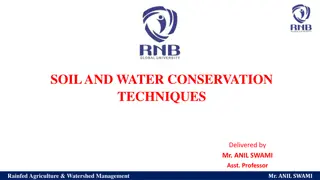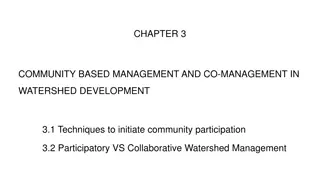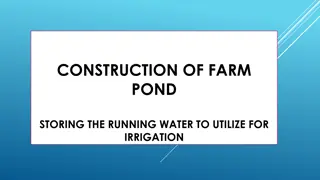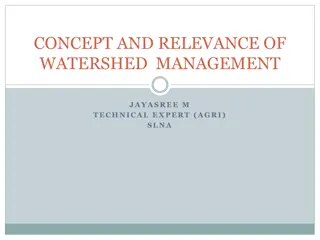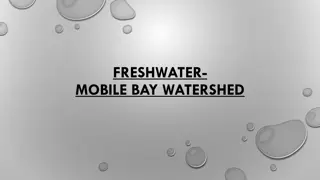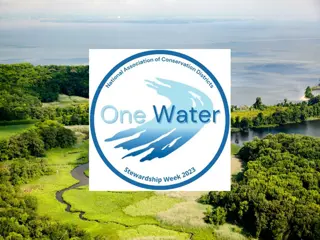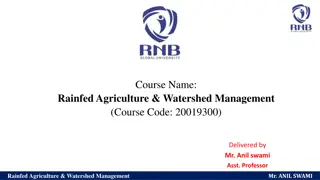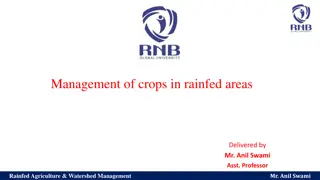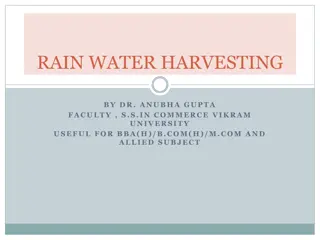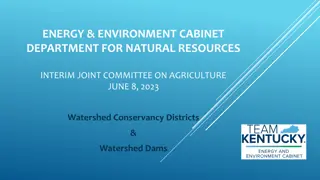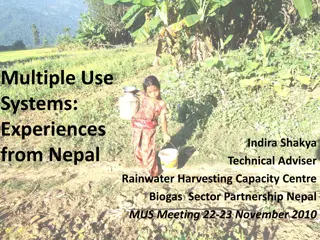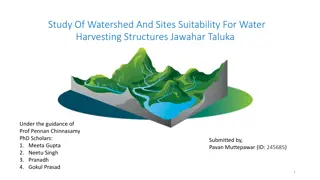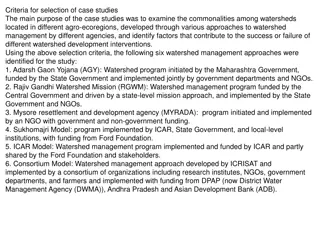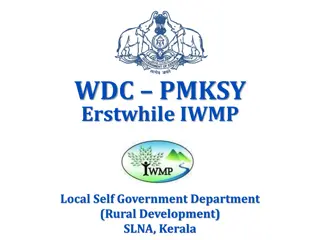Water Harvesting Techniques in Rainfed Agriculture & Watershed Management
Water harvesting plays a crucial role in rainfed agriculture by collecting and storing runoff water for irrigation in arid and semi-arid regions. Mr. Anil Swami, an assistant professor, discusses the importance of water harvesting techniques, including runoff farming and rainwater harvesting. He emphasizes the efficient utilization of water resources, contingent crop planning, and the components of water harvesting systems. Understanding soil and climatic conditions in rainfed areas is essential for effective water management.
Download Presentation

Please find below an Image/Link to download the presentation.
The content on the website is provided AS IS for your information and personal use only. It may not be sold, licensed, or shared on other websites without obtaining consent from the author.If you encounter any issues during the download, it is possible that the publisher has removed the file from their server.
You are allowed to download the files provided on this website for personal or commercial use, subject to the condition that they are used lawfully. All files are the property of their respective owners.
The content on the website is provided AS IS for your information and personal use only. It may not be sold, licensed, or shared on other websites without obtaining consent from the author.
E N D
Presentation Transcript
Water harvesting: Importance and Its techniques Delivered by Mr. Anil Swami Asst. Professor 1 Mr. Anil Swami Mr. Anil Swami Rainfed Agriculture & Watershed Management Rainfed Agriculture & Watershed Management
Objective:- Tell the soil and climatic conditions prevalent in rainfed areas. Interpret various water harvesting techniques and their efficient utilization. Apply contingent crop planning for aberrant weather conditions. Examine the seasonal rainfall and different types of watershed and its components. Select soil and water conservation techniques to avoid their losses. 2 Mr. Anil Swami Rainfed Agriculture & Watershed Management
Water harvesting Meaning: The process of runoff collection during periods of peak rainfall in storage tanks, ponds etc., is known as water harvesting. It is a process of collection of runoff water from treated or untreated land surfaces/ catchments or roof tops and storing it in an open farm pond or closed water tanks/reservoirs or in the soil itself (in situ moisture storage) for irrigation or drinking purposes. Mr. Anil Swami Rainfed Agriculture & Watershed Management
Runoff farming and rainwater harvesting agriculture are synonymous terms, which imply that farming is done in dry areas by means of runoff from a catchment. Runoff farming is basically a water harvesting system specially designed to provide supplemental or lifesaving irrigation to crops, especially during periods of soil moisture stress. Mr. Anil Swami Rainfed Agriculture & Watershed Management
Collecting and storing water for subsequent use is known as water harvesting. It is a method to induce, collect, store and conserve local surface runoff for agriculture in arid and semiarid regions. Water harvesting systems have three components viz., the catchment area, the storage facility and the command area. The catchment area is the part of the land that contributes the rain water. Mr. Anil Swami Rainfed Agriculture & Watershed Management
The storage facility is a place where the runoff water is stored from the time it is collected until it is used. The command area is where water is used. Water harvesting is done both in arid and semi-arid regions with certain differences. In arid regions, the collecting area or catchment area is substantially in higher proportion compared to command area. Mr. Anil Swami Rainfed Agriculture & Watershed Management
Actually, the runoff is induced in catchment area in arid lands whereas in semi-arid regions, runoff is not induced in catchment area, only the excess rainfall is collected and stored. However, several methods of water harvesting are used both in arid and semiarid regions Mr. Anil Swami Rainfed Agriculture & Watershed Management
The importance of water harvesting: 1. In arid and semi-arid areas where rainfall is low and unfavourably distributed, water harvesting makes farming possible on part of the land provided other production factors are favourable. 2. It can provide additional water to supplement rainfall to increase and stabilize crop production in dryland areas. Mr. Anil Swami Rainfed Agriculture & Watershed Management
3. It can alleviate (reduce) the risk associated with the unpredictability of rainfall in drought prone areas. 4. In remote areas (islands and deserts) where public water supply for domestic and animal rearing is not available, inducing runoff from treated area and stored in a reservoir/ cistern for later use is a common practice. 5. In islands and high hilly areas, due to limited extent of fresh water aquifers, rainwater harvesting is the most preferred source of water for domestic use. Mr. Anil Swami Rainfed Agriculture & Watershed Management
6. The arid lands suffering from desertification, water harvesting would improve the vegetative cover and help to halt (reduce/minimize) the environmental degradation. 7. Water harvesting arrest decline in groundwater levels, to overcome the inadequacy of surface water to meet our demands. Mr. Anil Swami Rainfed Agriculture & Watershed Management
Techniques of Rainwater Harvesting: The water harvesting techniques are classified into five groups. These are sketched as given below: Water harvesting is done both in arid and semi-arid regions with certain differences. Mr. Anil Swami Rainfed Agriculture & Watershed Management
Mr. Anil Swami Rainfed Agriculture & Watershed Management
13 Mr. Anil Swami Mr. Anil Swami Rainfed Agriculture & Watershed Management Rainfed Agriculture & Watershed Management


